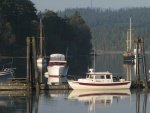I used to have buddy bearings--but I began to realize that pumping in grease being a plate does not guarantee that there will be good grease around the bearings. After pulling the "Buddy Bearing" cup/plate a few times, I realized that there can be moisture around the bearings, and the buddy bearing system does not allow you to see and correct this.
How does moisture get into the bearing area? Most common cause is to put the boat in the water with hot bearings. The material contracts, with the cold water, and moisture goes into this chamber. As the bearing heats up again, then this moisture becomes dispersed throat the grease pack, and then gets to the bearings, and have minor corrosion of the bearings. The advocates of the Buddy bearings say that the spring pressure keeps water out. I have not found that to be true. Water is going to get in with any system--except the oil bath...
I agree that the buddy bearing cup be tapped out--I know you can do it Pat!. You can correspond with us on the phone or internet for specifics when you hit a snag. Then you can take a finger in, (gloved hand), and scoop out the old grease. To do it right, it is best to undo the nut (held in place with a cotter pin). Then look at the bearings, clean any old or "cruddy grease"--then repack--as above. top off the grease with the buddy bearings.
I have come to like the "Posi lube" which injects new grease thru the center of the axle spindle, and displaces old grease. The EZ Lube system is similar, but injects the new grease in the back of the hub, thru a side of the hub, Zerk fitting (but I feel harder to use). When I am doing a lube before a trip, I pump in new grease until the old grease is fully displaced.
Here is a discussion we have had in the past:
http://www.c-brats.com/viewtopic.php?t=10063
Irregardless, Pat now has the Buddy Bearing, and I believe should visually check the grease, and bearings status. Keep the Buddy Bearing, and do a yearly check on the grease/bearings.
Why should you know how to change the grease, and get to the bearings? If you have a bearing go bad in remote areas, it is easier, and faster to change the bearings yourself, than call for "help"--which may not have the parts to fix it.
So...learn how, carry several extra set of bearings, cotter pins (I also carry a spare hub), some also carry a spare spindle. Have a jack which will pick up the trailer, chocks for the wheels, a lug wrench, and some simple basic tools--water pump pliers, long nose pliers, screwdriver (to remove the spindle nut)--extra grease, and a grease gun. I now have a Lincoln commercial air powered grease gun, and it makes to greasing so much easier.

